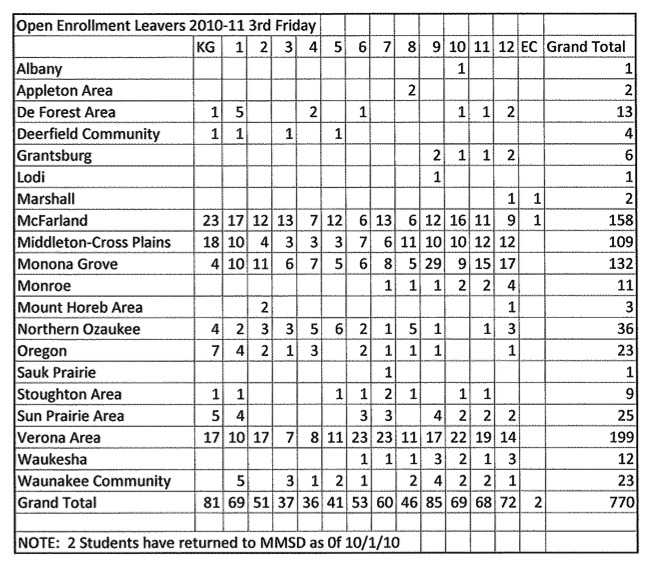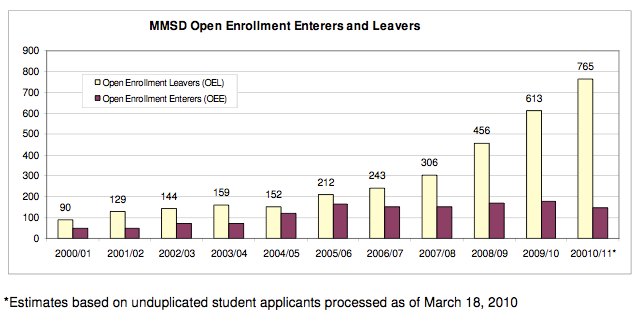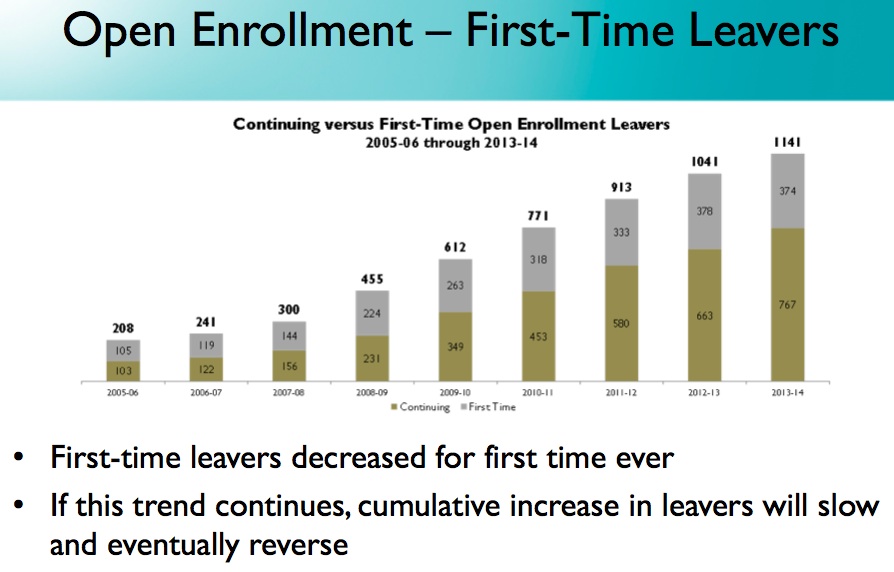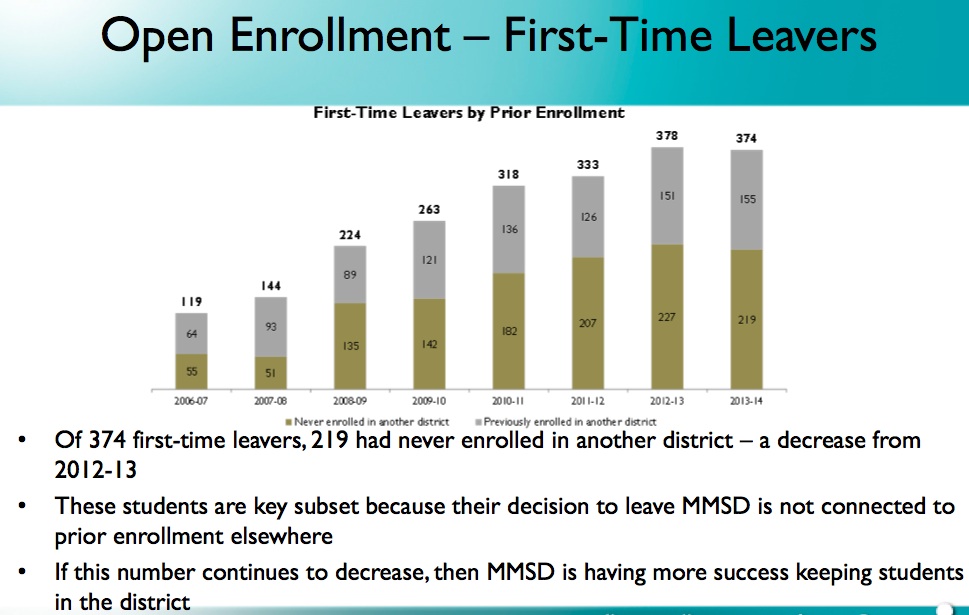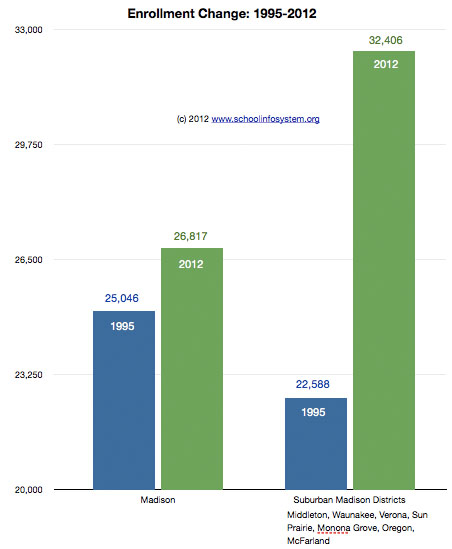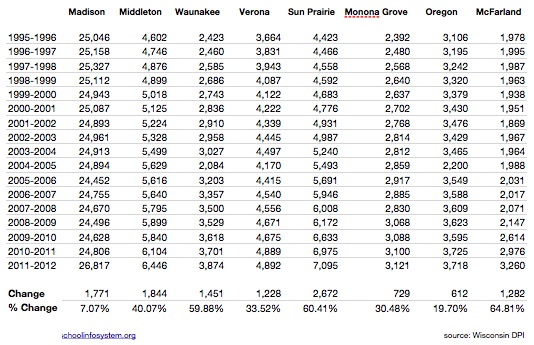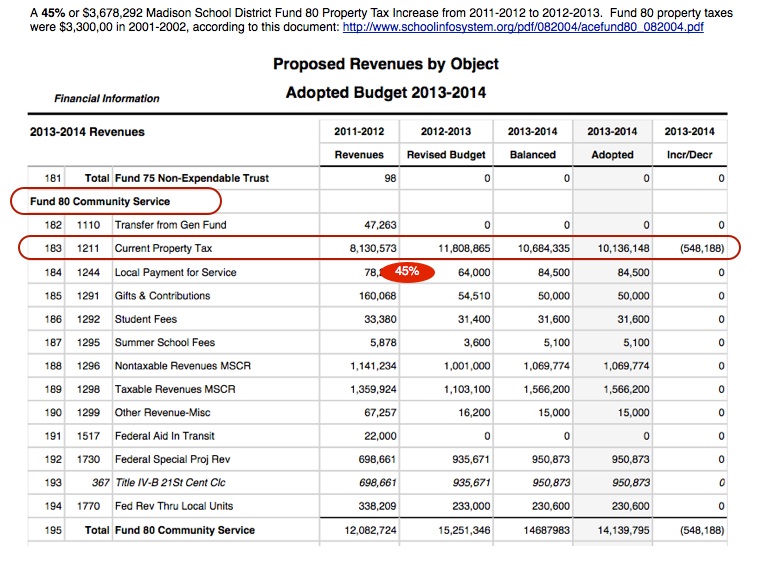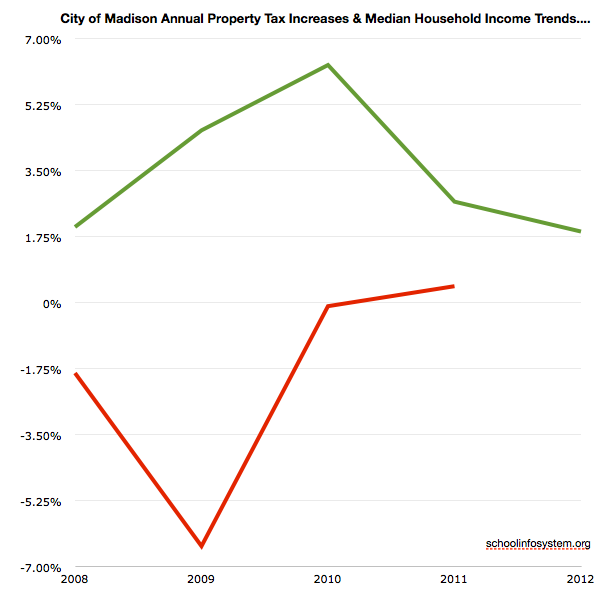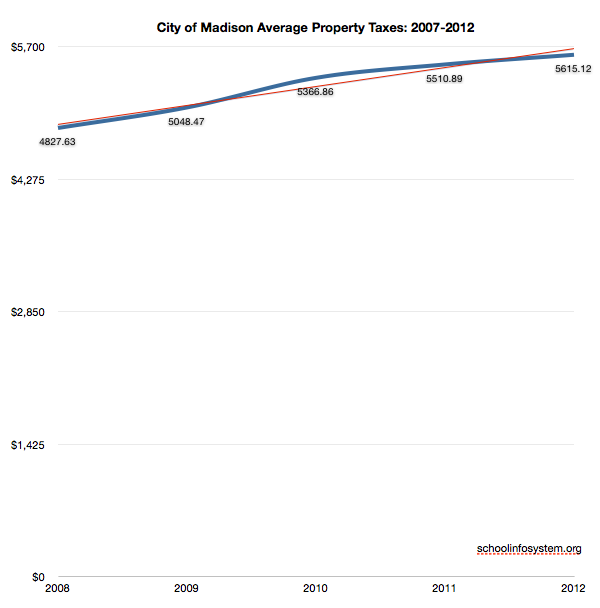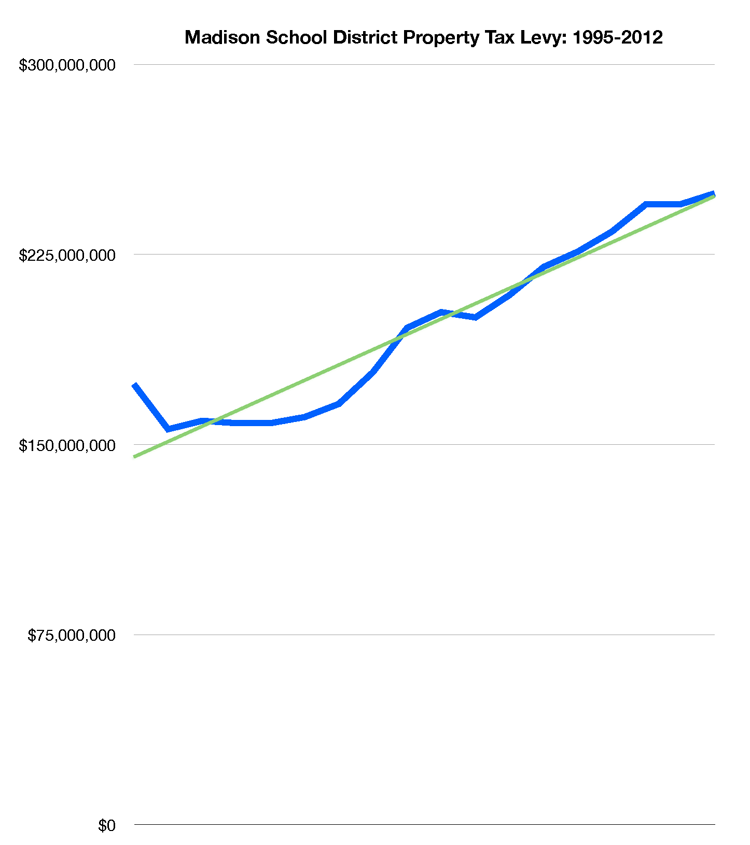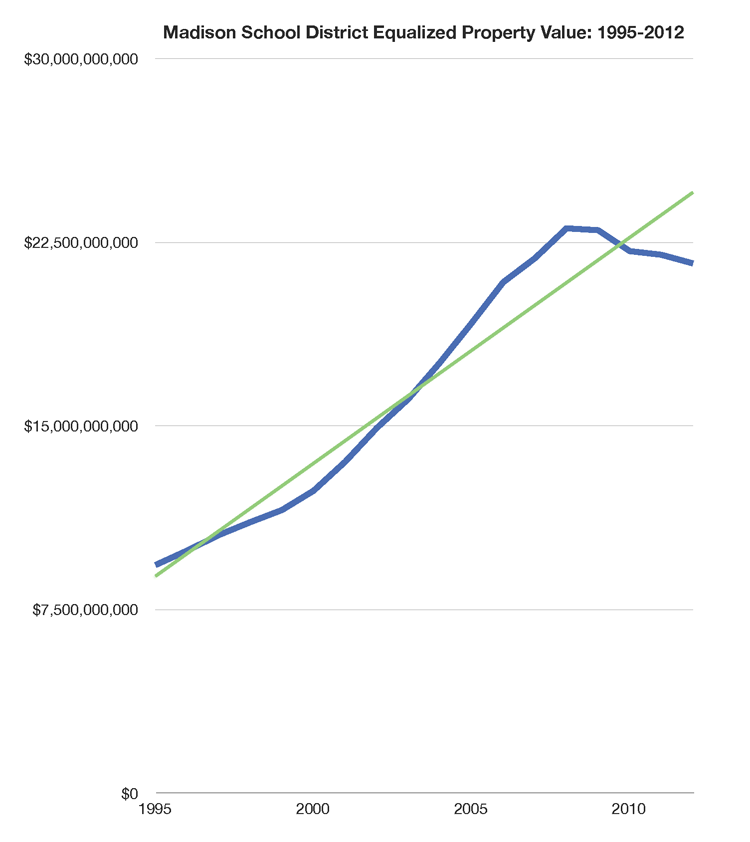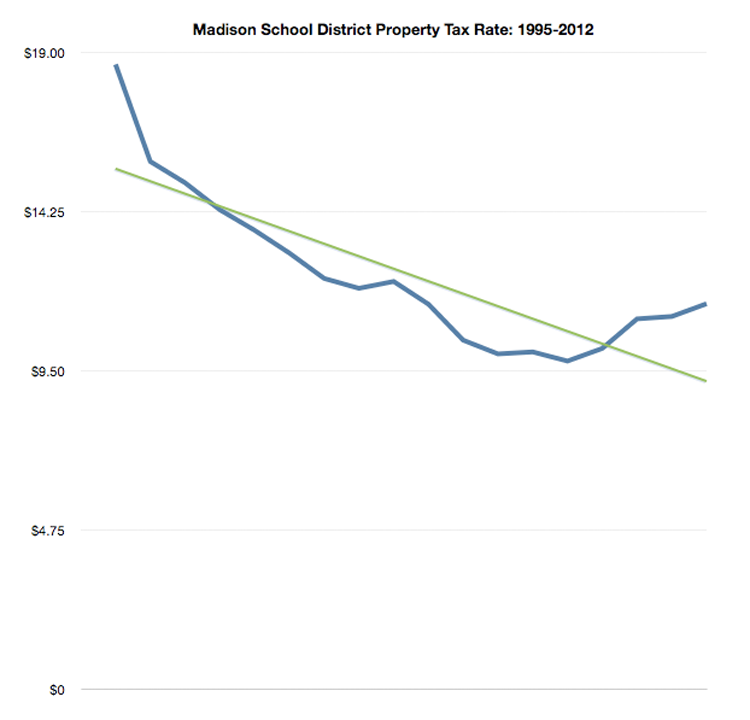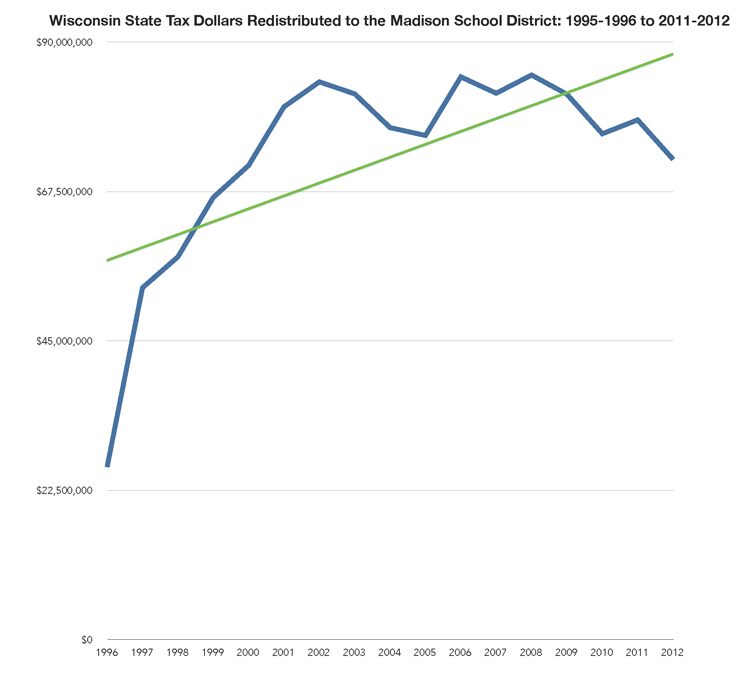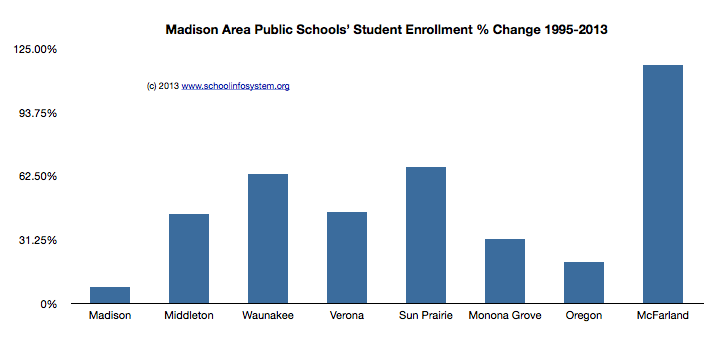Search Results for: outbound open enrollment
Commentary on Madison’s Growing Outbound Open Enrollment Count, despite substantial spending growth
Doug Ericsson: The financial ramifications are significant. A school district gaining a student receives a share of the student’s home district’s state aid to help pay for educating that student. The Madison School District will lose about $6.5 million in state aid this school year because of open enrollment, the report said. “Obviously, I am […]
Madison Schools’ Outbound Open Enrollment Continues to Grow; 2015-2016 Budget is $454,414,941.93
Madison Government School District “Final” 2015-2016 Budget (5.2MB PDF): Page 39: 2013-2014 Total Spending: $408,806,234.75 2014-2015: $411,671,817.67 2015-2016: $454,414,941.93 or $16,724.26 per student (27,171 students) The United States spends $12,401 per student nationally, about 34% less than Madison. Much more on open enrollment, here.
Madison School District’s Outbound Open Enrollment Increases to -1206 (-836 net out)
MMSD financial results for 2012-13 were favorable in comparison to budget expectations. The General Fund Balance, which was budgeted to decrease by ($5.5) million to support several one-time expenditures, actually decreased by just ($1.6) million. This puts the District’s balance sheet in a stronger opening position for 2013-14. The primary reason for the favorable result was an unbudgeted revenue influx of $3.2 million from Medicaid reimbursements.
However, the Food Service Fund struggled in 2012-13, recording a net loss of $386,000 on total revenues of $10.5 million. Labor cost overages were the primary cause of the net loss. The Business Office is working closely with the Food Service department on budgetary expectations for 2013-14. Overall participation in the program decreased slightly last year.
….
Open enrollment results show 370 students enrolling in to MMSD from elsewhere and 1,206 MMSD residents enrolling outside of the district. The net out is -836. (Enrollment background data & District statistics)
(Last year, MMSD had 379 students enrolling in and 1,118 enrolling out, for a net out of -739.)Much more on open enrollment here.
Suburban Districts vs. Madison, 1995-2012.
Madison School District: Private/Parochial, Open Enrollment Leave, Open Enrollment Enter, Home Based Parent Surveys (June, 2009).
Madison School District 2010-2011 Enrollment Report, Including Outbound Open Enrollment (3.11%)
136K PDF
A few numbers:
Total District Enrollment 24,796 (The Wisconsin DPI enrollment number for Madison is 25,395).
Open Enrollment Leavers: 772
Open Enrollment Enterers: 175
Much more on outbound open enrollment here.
Tax & spending authority are largely based on enrollment.
The most recent 2010-2011 budget document indicates total planned spending of $373,157,148, which yields $15049.08 per student.
Madison School Board’s vote (to limit Outbound Open Enrollment) hurts kids — and the city
Open enrollment allows students to go to schools outside their district. If “school choice” and “vouchers” are the buzz words popping into your head right now, you’re probably not alone. When the legislation passed in 1997, it was in the same ballpark as those two old Republican saws. Open enrollment supposedly introduces choice to the public education “marketplace,” forcing districts to compete and get better.
Democrats typically see such policies as the first step toward balkanizing the public schools into the haves and have-nots, when they should be a hallmark of a society in which any kid can become president.
Open enrollment has not shown a particularly good light on Madison in recent years. More kids have been transferring out than in, with the net loss last year 435 students. The resolution the school board passed Monday calls on the state to allow districts to limit the students that could leave under open enrollment “if the school board believes the fiscal stability of the district is threatened.”
Clearly, district leaders feel open enrollment is a fiscal threat; their analysis shows it created about a $2.7 million hole in the district budget last school year.Much more on the Madison School District’s attempt to limit outbound open enrollment here.
Madison’s Attempts to Limit Outbound Open Enrollment: A Discussion with Vicki McKenna & Don Severson
two mp3 audio files, via a kind reader’s email: 30mb. The open enrollment conversation begins at about 19:40 in this first mp3 file and continues in the second (33mb) mp3 file.
Much more on outbound open enrollment here.
Madison School District’s Attempt to Limit Outbound Open Enrollment, via a WASB Policy Recommendation
Fascinating: I don’t think this will help. The Madison School District 55K PDF:
WASB Policy Modifications Related to Open Enrollment Recommended changes to the current WASB resolution on open enrollment (Policy 3.77):
Current f.: The options for the districts to limit the number of students leaving the school district under the open enrollment program, if the school board believes that number is large enough to threaten the viability of the district.
Proposed f.: The option for the districts to limit the number of students leaving the school district under the open enrollment program, if the school board believes the fiscal stability of the district is threatened.
Rationale – As school districts are confronted by a combination of revenue limits and declining state aid, fiscal issues are overriding attention paid to the educational programs offered to our children. The law originally limited open enrollment transfers to 3% of a district’s total enrollment and was designed to provide parents with enrollment options for their students.
Now, districts lack the flexibility or capacity to adjust to large scale student population shifts. Districts already fiscally weakened by nearly two decades of revenue limits, and more recently, cuts to general state aids – particularly in small, rural districts – are left with the options of dissolving the district, or Draconian cuts to the educational program.
**********
Current i.: The WASB supports a clarification in state statutes to limit the number of students enrolling in nonreSident school districts to 10 percent of the resident district membership.
Proposed i.: The WASB supports limiting the number of students enrolling in nonresident school districts to 3 percent of the resident district membership.
Rationale – The law originally capped open enrollment to 3% of a district’s total enrollment. This change returns control of open enrollment transfers to locally elected school board members. If districts choose to limit open enrollment transfers to less than 3%, correspondingly, a district would have to use the same method/policy for accepting students through open enrollment. **********
Proposed i: The WASB supports a fiscally neutral exchange of state dollars in open enrollment transfers.
Rationale – Current law requires that a sending district pay the receiving school district approximately $6,500. The $6,500 payment is the estimated statewide cost of educating a student; however, in practice this amount doesn’t really reflect the costs of educating a student in the receiving district, or takes into account the loss of revenue to the sending district.
The law could be changed by lowering the dollar amount to $5,000, or the amount of state aid per pupil received by the sending district in the prior year, whichever is less.
While the WASB supports public school open enrollment, participation in the program should not be a fiscal hardship. The current state/nation fiscal climate and local economic circumstances confronted by school districts, has dramatically changed the fiscal equation and requires modifications to the state’s open enrollment law.
Approved by the School Board of: Madison Metropolitan School District Date: 9/13/10
kt:4tf,s;:.C~ Signed: (Board President)Related: Madison School Board Discussion: Private/Parochial, Open Enrollment Leave, Open Enrollment Enter, Home Based Parent Surveys.
The essential question: do these proposed open enrollment changes benefit students, or adult employment?
Madison School District Outbound Open Enrollment Applications 2010-2011 School Year; As of 3/18/2010
Complete Report 36k PDF, via a kind reader:The pattern of an increasing number of open enrollment transfer applications continued this spring. As of March, 18, 2010 there were 765 unique resident MMSD students applying to attend non-MMSD districts and schools. The ratio of number of leaver applications to enterer applications is now 5:1.
It is important to note that not all applications result in students actually changing their district or school of enrollment. For example, for the 2009-10 school year although 402 new open enrollment students were approved by both MMSD and the non-resident districts to attend the non-resident district, only 199 actually were enrolled in the non-resident district on the third Friday September 2009 membership count date. Still, the trend has been upward in the number of students leaving the district.Related: 2009 Madison School District Outbound Open Enrollment Parent Survey.
A school district’s student population affects its tax & spending authority.
Madison School District’s Outbound Open Enrollment for 2009/2010
648 (2.68% of the District’s enrollment) students open enrolled out for the 2009/2010 school year. 217 high school, 127 middle school and 304 elementary students. [704K PDF: pages 14, 15 and 16]
More on the history of Wisconsin open enrollment, here. Enrollment numbers drive a school district’s tax and spending authority. Wisconsin Open Enrollment website.
Commentary on Madison’s special Education and “inclusive” practices; District enrollment remains flat while the suburbs continue to grow
Pat Schneider: That was one issue that brought together family activists who formed Madison Partners for Inclusive Education [duckduckgo search] in 2003, Pugh said. “A parent in an elementary school on the west side could be seeing high-quality inclusive expert teaching with a team that ‘got it,’ and someone on the east side could be […]
Madison Schools’ Enrollment Trends Presentation; Open Enrollment Comments
The Madison School District (PDF).
Related: 2009 Outbound Open Enrollment Parent Survey.
Madison’s attempts to limit outbound open enrollment. Much more on open enrollment, here.
Which Madison schools are losing the most students to open enrollment?
he number of students that have left Madison schools for other districts through the state’s public school open enrollment program has grown every year since 2005.
But which schools are those students leaving? Our graphic below uses Madison Metropolitan School District data to show the number of leavers — the term used for students who live in the Madison district but go to school in another — by which school’s attendance area they live in. (Note that the open enrollment program doesn’t apply to students who leave for private schools or to be home-schooled.)
By percentage of enrollment, the schools with the most leavers were Glendale Elementary (83, 17.5 percent), Leopold Elementary (67, 10.2 percent), Toki Middle (48, 9.4 percent) and La Follette High (121, 8.2 percent). Memorial High has the highest number of leavers at 134, but its higher enrollment put it only eighth when ranked by percentage (7.3 percent).
Of the 1,041 leavers for the 2012-13 school year, 494 were from elementary schools, 188 were in the middle school grades 6 through 8 and 359 were at the high school level.
The Monona Grove School District was the most popular destination for the leavers, followed closely by Verona and McFarland. Students left Madison for 25 districts, but data for how many attended each was not fully available because the district can’t report small numbers due to privacy concerns.Much more on outbound open enrollment here.
Paul Vallas visits Madison; Enrollment Growth: Suburban Districts vs. Madison 1995-2012
Related:
- Where Have All the Students Gone (November, 2005)?
- Where Have all the Students Gone? An Update (January, 2008)
- Madison School District Outbound Open Enrollment.
- Open Enrollment Leavers Survey
Paul Vallas will be speaking at Madison LaFollette high school on Saturday, May 26, 2012 at 1:00p.m. More information, here.
Much more on Paul Vallas, here.
Directions.
Per Student Spending:
I don’t believe spending is the issue. Madison spends $14,858.40/student (2011-2012 budget)
Middleton’s 2011-2012 budget: $87,676,611 for 6,421 students = $13,654.67/student, about 8% less than Madison.
Waunakee spends $12,953.81/student about 13% less than Madison.
A few useful links over the past decade:
- Notes and links on Madison Superintendent hires since 1992 (2007).
- English 10
- Small Learning Communities
- Connected Math
- Reading Recovery
- When all third graders read at grade level or beyond by the end of the year, the achievement gap will be closed…and not before
- Madison School Board member may seek audit of how 2005 maintenance referendum dollars were spent
- Madison Preparatory Academy
More time for open enrollment
Wisconsin’s public school open enrollment period begins Monday, and for the first time, families will have three months to decide whether and where to enroll their students outside of their home school district.
For the Madison School District, the extra time could mean more families choosing to leave for other districts or virtual schools, though Superintendent Dan Nerad said it’s too early to know what the affect will be.
“By the nature that there’s an open window, that’s likely to happen for us as well as other districts around the state,” Nerad said.
Gov. Scott Walker signed legislation last week extending the official open enrollment period from three weeks in February to three months. Applications must be completed by April 30.
Proponents of the change, including school choice advocates and the virtual school industry, tout open enrollment as giving parents and students more control of their educational options.Related: Madison School District Outbound Open Enrollment Applications 2010-2011 School Year; As of 3/18/2010.
Open Enrollment Changing the Face of Wisconsin Public Schools
Wisconsin Taxpayers Alliance, via a kind Senn Brown email:
In 2010-11, a record number of students took advantage of Wisconsin’s open enrollment program to attend school elsewhere than in their own district. The 34,498 participants was 8.1% higher than in 2010 and nearly five times higher than in 2001. Open enrollment numbers varied widely, with 13 districts experiencing net outflows of more than 10% of their student populations and 34 with net inflows of similar magnitude. These findings are detailed in SchoolFacts11, the annual reference book from the Wisconsin Tax- payers Alliance (WISTAX) that provides, for every school district in the state, a wide range of information on enrollment, finance, staffing, and test scores.
In 2010-11, 4.0% of Wisconsin’s public school students attended a district other than their own. Dover (26.2%) and South Shore (23.0%) both had net outflows (students leaving less those coming) of more than 20%. Eleven other districts (Florence, Mercer, Neosho, Palmyra-Eagle, Richfield, Stockbridge, Twin Lakes, Washington-Caldwell, Wheatland, Winter, and Wonewoc-Union Center) had net outflows of over 10%.Related: Madison School District 2009 outbound open enrollment survey. Much more, here.
Wisconsin Legislature mulls changes to open enrollment program
As families begin to enroll their students Monday in virtual schools or neighboring districts through the state’s open enrollment process, the Legislature is debating changes to the program.
The Senate approved a bill this week that would extend the enrollment period from three weeks in February to three months, starting this year. The bill still needs approval in the Assembly and the governor’s signature.
The changes would make it easier for parents who want to enroll their students in public schools outside their own district, but may not be thinking about that decision in February, said Sen. Luther Olsen, R-Ripon, who introduced the bill.
Democrats opposed the changes, however, saying the wider window will cause administrative hassles and uncertainty for school districts about proper staffing levels as they try to budget for the next school year.Much more on open enrollment, here.
Proposed Changes in Madison’s Open Enrollment Policy
The attached proposed changes to Policy 4025 reflect the amendments to Wis. Stat. §118.51, which now permits a nonresident district to consider whether a student has been habitually truant for purposes of allowing open enrollment into the non-resident district. This change applies to students who lived in the district, moved outside of the district boundaries, and are seeking to stay in the district as a nonresident student. A second change allows a district to prohibit a nonresident student from attending district schools after an initial acceptance if the student is habitually truant during either semester of the current school year. The open enrollment period begins February 7, 2011 and ends February 25, 2011.
Much more on open enrollment, here.
Wisconsin’s 2011-2012 open enrollment application period is February 7, 2011 to February 25, 2011.
Response to Madison West High Parents’ Open Letter
Madison School Board Member Ed Hughes:
As to the first point, I wish people were a bit less concerned about what will inconvenience or irritate our teachers and a bit more concerned about what’s best for our students. I think it is absolutely correct that the alignment plan will reduce the autonomy of teachers. Classes will have to be designed and taught against an overriding structure of curricular standards that will need to be addressed. I think that is a good thing.
We’d all like the freedom and autonomy to be able to define our own job responsibilities so that we could spend our time exclusively on the parts of our jobs that we particularly like and are good at, but that is certainly not the way that effective organizations work. I believe that teachers need to be held accountable for covering a specific, consistent, coherent and rigorous curriculum, because that is what’s best for their students. I don’t see how holding teachers to curriculum standards should inhibit their skills, creativity or engagement in the classroom.
The second point concerns 9th and 10th grade accelerated class options and the accusation that this will result in “segregation.” This line of argument has consistently bothered me.
We don’t hear much from African-American parents who are upset about the possibility of accelerated classes because, as the open letter puts it, they will result in “more segregation.” On the contrary, we on the Board have heard a number of times from middle class African-American parents who are dissatisfied, sometimes to the point of pulling their kids from our schools, because their kids regularly experience situations where well-meaning teachers and staff assume that because the kids are African-American, they’ll need special help or won’t be able to keep up with advanced class work. I think that frustration with this essentially patronizing attitude has contributed to community support for the Madison Prep proposal. It seems to me that the open letter suggests the same attitude.It will be interesting to see how the course options play out. I suspect this will be a marathon, as it has been since the grant driven small learning community initiative and the launch of English 10 some years ago.
I very much appreciate Ed’s comments, including this “a bit more concerned about what’s best for our students”.
Lots of related links:
- “Stand Up Against the MMSD High School Reform”
- Madison school district to consider alternatives to traditional public schools
- Advanced Placement, Gifted Education & A Hometown Debate
- On the Gifted & Talented Complaint Against the Madison School District
- Madison School District 2010-2011 Enrollment Report, Including Outbound Open Enrollment (3.11%)
- Complaint Filed Against Madison Schools
- English 10
- District Small Learning Community Grant – Examining the Data From Earlier Grants, pt. 2
- An Update on Madison’s High School Reforms
- Madison School District High School Planning Meeting Video
More here.
Memo to the Media on Open Enrollment: When We (The Madison School Board) Unanimously Reject a Proposal, That Means We Don’t Support It
Madison School Board Member Ed Hughes:
The Board discussed the issue. Individual members expressed concern about the 3% cap, suggesting that this wasn’t the way for us to deal with the open enrollment issue. I was one of those who spoke against the proposal. The Board voted unanimously to support the other two proposed changes to WASB policy, but not the 3% cap. This amounted to a unanimous rejection of the 3% limit. (A video of the Board meeting can be found here. The WASB discussion begins about 48 minutes in.)
From the Board’s perspective, the endorsement of the proposal regarding financial stability wasn’t seen as one that had much bearing on our district. But we’d like support from other districts on our push for a fiscally neutral exchange of state dollars, and so we were willing to support proposals important to other districts, like this one, as a way of building a coalition for fresh consideration of open enrollment issues by the WASB.
The “financial stability” proposal certainly wasn’t intended by us as a dagger to the heart of the open enrollment policy; I don’t suppose that it was ever the intent of the legislators who supported the open enrollment statute that the policy could render school districts financially unstable.
The State Journal never reported that the Board rejected the 3% cap proposal. It ran letters to the editor on Wednesday, Thursday and Friday that all seemed premised on the assumption that we had in fact supported such a cap. The Wednesday letter said in part, “[T]he Madison School District’s answer to its shortcomings is to build a Berlin wall, preventing students from leaving.” From the Thursday letter, “Unfortunately, instead of looking inward to address the problems and issues causing flight from Madison schools, the School Board would rather maintain the status quo and use the coercive force of government to prevent its customers from fleeing for what they think is a better value.” From Friday’s letter: “So the way you stem the tide of students wanting to leave the Madison School District is to change the rules so that not so many can leave? That makes perfect Madison School Board logic.” (The State Journal also ran a letter to the editor on Friday that was more supportive of the district.)Much more on outbound open enrollment and the Madison School Board here.
I’m glad Ed continues to write online. I continue to have reservations about the “financial stability” angle since it can be interpreted (assuming it becomes law…. what are the odds?) any way the Board deems necessary. Further, I agree with Ed that there are certainly more pressing matters at hand.
Mitch Henck Discusses Madison’s Attempts to Restrict Open Enrollment
15.8MB mp3 audio file, via a kind reader.
Related:
A Partial Look (School Climate) at the Outbound Madison School District Parent Survey
Madison school district parents dissatisfied with local schools got a boost after a 2007 U.S. Supreme Court decision which trumped state law and made it easier for students living in the district to attend schools in other districts, a practice known as open enrollment.
The case was brought by Seattle parents who challenged the use of race in assigning students to schools, arguing it violated the Constitution’s right of equal protection. The ruling was celebrated by those who favor color-blind policies, but criticized by civil rights groups as a further erosion of Brown vs. Board of Education, the landmark 1954 case that outlawed school segregation.
Last year it became easier in Madison, and in school districts across the country, for white students to transfer even if it meant increasing the district’s racial imbalance.
After a flood of local students left the district last year, Madison Superintendent Dan Nerad decided to investigate why.
“We had an interest in knowing ideas from people that had made the decision for open enrollment,” Nerad says. “We are attempting to learn from those experiences to see if there are some things as a school district that we can constructively do to address those concerns.”
To that end, the district surveyed households of district residents who left Madison schools and transferred to another district for the 2008-09 school year to find out why the families left. The majority of parents who took their kids out of the Madison school district last year under open enrollment said they did so for what the district classifies as “environmental reasons”: violence, gangs, drugs and negative peer pressure. Other reasons were all over the map. Many cited crowded classrooms and curriculum that wasn’t challenging enough.
Only a few responses pointed directly to white flight.The Private/Parochial, Open Enrollment Leave, Open Enrollment Enter, Home Based Parent Survey, including School Board discussion, can be found here. David Blask comments.
Madison’s Population Grew 22,491 from 2000 to 2008, School Enrollment Flat
Madison continued its remarkable population surge with a 10.7% increase from 2000 to 2008, top among Wisconsin cities with a population of 50,000 or more. The capital also led Wisconsin in numerical growth, adding 22,491 people, for a total population of 231,916.
“Madison remains a very desirable place to live, and positive growth rates like this reflect that high quality of life,” Madison Mayor Dave Cieslewicz said in a statement.
The new estimates are intriguing, both locally and nationally, because they detail America’s population at the cusp of the financial meltdown and in the midst of a housing bust. They’re also the last estimates to be released before the 2010 census is taken.
“Big cities are resilient,” said William H. Frey, a demographer with the Brookings Institution in Washington, D.C. “They’ve been able to survive in a very difficult economy. These cities have diverse economies that can hold their own in these troubled times.”Related:
- Where have all the students gone?
- increased outbound open enrollment applications from the Madison School District
- A bit of historic enrollment and staffing data.
- Credit for Non-MMSD Classes
Madison’s enrollment was 24,758 during the 1999-2000 school year and 24,189 during the 2008-2009 academic year. More here and here.
Given Madison’s academic orientation (UW-Madison, MATC, Edgewood College, not to mention a number of nearby institutions), our students (every one of them) should have access to world class academics.
Madison Talented & Gifted Update & Interesting MAP Test Results, By School
Reminders of Best Practice
Current Practice
Data from MMSD
Review input from Focus Groups
Examine Implications for Policy
Examine Implications for PracticeRelated: Parent talented & gifted complaint, MAP Assessment results, English 10, credit for non-Madison school district courses and outbound open enrollment.
45% (!) Increase in Madison Schools’ Fund 80 Property Taxes from the 2011-2012 to 2012-2013 School Year; No Mention of Total Spending
July, 2013 Madison Schools 2013-2014 Budget Presentation (PDF). Notes:
- No mention of total spending…. How might the Board exercise its oversight obligation without the entire picture?
- The substantial increase in redistributed state tax dollars (due to 4K) last year is not mentioned. Rather, a bit of rhetoric: “The 2013-14 budget development process has focused on actions which begin to align MMSD resources with the Strategic Framework Priorities and strategies to manage the tax levy in light of a significant loss of state aid.” In fact, according to page 6, the District expects to receive $46,392,012 in redistributed state tax dollars, which is a six (6%) increase over the funds received two years ago.
- The District’s fund equity (financial cushion, or reserves) has more than doubled in the past eight years, from $22,368,031 in 2005 to $46,943,263 in 2012.
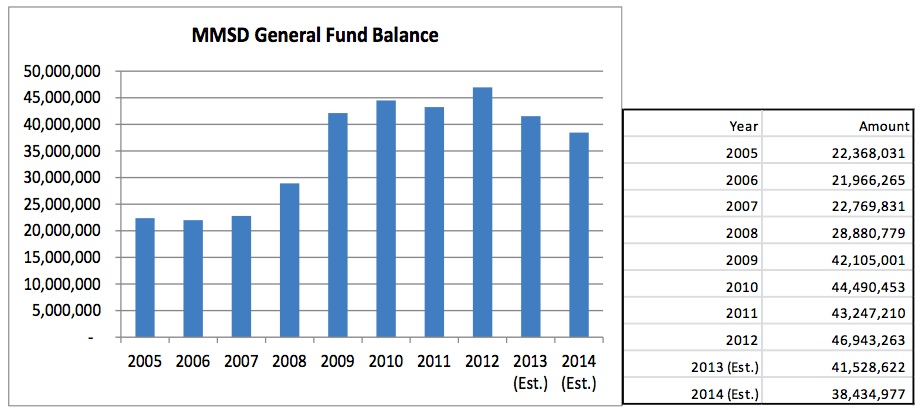
- Outbound open enrollment continues to grow, up 14% to 1,041 leavers in 2013 (281 inbound from other Districts).
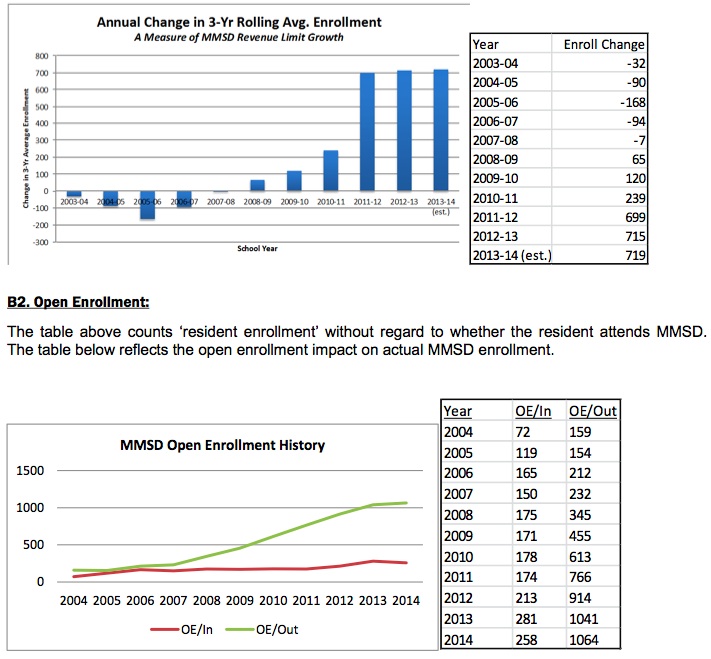
- There is no mention of the local tax or economic base:
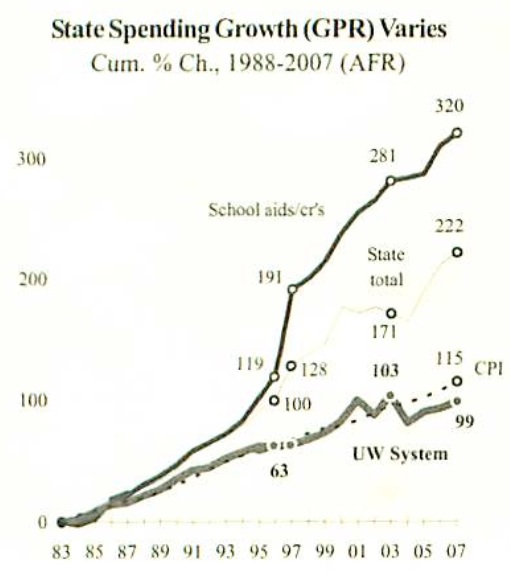
- The growth in Fund 80 (MSCR) property taxes and spending has been controversial over the years. Fund 80, up until recently was NOT subject to state imposed property tax growth limitations.
- Matthew DeFour briefly summarizes the partial budget information here. DeFour mentions (no source referenced or linked – in 2013?) that the total 2013-2014 budget will be $391,000,000. I don’t believe it:
The January, 2012 budget document mentioned “District spending remains largely flat at $369,394,753” (2012-2013), yet the “baseline” for 2013-2014 mentions planned spending of $392,807,993 “a decrease of $70,235 or (0.02%) less than the 2012-13 Revised Budget” (around $15k/student). The District’s budget generally increases throughout the school year, growing 6.3% from January, 2012 to April, 2013. Follow the District’s budget changes for the past year, here.
Finally, the document includes this brief paragraph:
Work will begin on the 2014-15 early this fall. The process will be zero-based, and every line item and FTE will be carefully reviewed to ensure that resources are being used efficiently. The budget development process will also include a review of benefit programs and procurement practices, among other areas.
One hopes that programs will indeed be reviewed and efforts focused on the most urgent issues, particularly the District’s disastrous reading scores.
Ironically, the recent “expert review” found that Analysis: Madison School District has resources to close achievement gap. If this is the case (and I agree with their conclusion – making changes will be extraordinarily difficult), what are students, taxpayers and citizens getting for the annual tax & spending growth?
I took a quick look at property taxes in Middleton and Madison on a $230,000 home. A Middleton home paid $4,648.16 in 2012 while a Madison home paid 16% more, or $5,408.38.
The Process for Discussing Madison School District High School Alignment
This is to provide clarity, transparency and direction in improving our high school curriculum and instruction, with ongoing communication.
(As presented to the MMSD Board of Education on January 6, 2011)
The following guiding principles were discussed:
- We will be aligning to the ACT Cateer and College Readiness Standards and the Common Core Standards
- This will be a comprehensive Pre K-12 process, to build continuity across all grade levels
- We will be implementing aligned assessments, including the Educational Planning & Assessment System (EPAS)
- The high school alignment will focus on grades 9 and 10 in the four core content areas
- We will establish common understandings, knowledge and skills using Universal Designs for Learning (UDL)
Lots of related links:
- “Stand Up Against the MMSD High School Reform”
- Madison school district to consider alternatives to traditional public schools
- Advanced Placement, Gifted Education & A Hometown Debate
- On the Gifted & Talented Complaint Against the Madison School District
- Madison School District 2010-2011 Enrollment Report, Including Outbound Open Enrollment (3.11%)
- Complaint Filed Against Madison Schools
- English 10
- District Small Learning Community Grant – Examining the Data From Earlier Grants, pt. 2
- The Mess at West (updated)
- Laurie Frost and Lorie Raihala: Issues at West High are long-standing
‘Embedded honors’ program has issues
The controversy at West High School continues about the Madison School District’s new talented and gifted program. Students, parents and teachers decry the plan, pointing to the likelihood of a “tracking” system and increasingly segregated classes.
While I am in agreement with them here, I must differ when they mistakenly point to the current “embedded honors” system as a preferable method for dealing with TAG students.
The idea itself should immediately raise red flags. Teaching two classes at the same time is impossible to do well, if at all. Forcing teachers to create twice the amount of curriculum and attempt to teach both within a single context is unrealistic and stressful for the educators.
The system creates problems for students as well. There is very little regulation in the execution of these “embedded honors” classes, creating widely varying experiences among students. By trying to teach to two different levels within one classroom, “embedded honors” divides teachers’ attention and ultimately impairs the educational experiences of both groups of students.
While the concerns raised about Superintendent Dan Nerad’s plan are legitimate, “embedded honors” as a solution is not.Lots of related links:
- “Stand Up Against the MMSD High School Reform”
- Madison school district to consider alternatives to traditional public schools
- Advanced Placement, Gifted Education & A Hometown Debate
- On the Gifted & Talented Complaint Against the Madison School District
- Madison School District 2010-2011 Enrollment Report, Including Outbound Open Enrollment (3.11%)
- Complaint Filed Against Madison Schools
- English 10
- District Small Learning Community Grant – Examining the Data From Earlier Grants, pt. 2
- The Mess at West (updated)
- Laurie Frost and Lorie Raihala: Issues at West High are long-standing
A rebellion at Madison West High School over new curriculum
When Paul Radspinner’s 15-year-old son Mitchell wanted to participate in a student sit-in last October outside West High School, he called his dad to ask permission.
“He said he was going to protest, and wanted to make sure I had no problem with it. I thought, ‘It’s not the ’60s anymore,'” recalls Radspinner. The students, he learned, were upset about planned curriculum changes, which they fear will eliminate elective class choices, a big part of the West culture.
“It was a real issue at the school,” notes Radspinner. “The kids found out about it, but the parents didn’t.”
This lack of communication is a main reason Radspinner and 60 other parents recently formed a group called West Cares. Calling itself the “silent majority,” the group this month opposed the new English and social studies honors classes the district is adding next fall at West, as well as Memorial. (East and La Follette High Schools already offer these classes for freshmen and sophomores.)
The parents fear separating smarter kids from others at the ninth-grade level will deepen the achievement gap by pushing some college-bound students into advanced-level coursework sooner. They also believe it will eviscerate West’s culture, where all freshmen and sophomores learn main subjects in core classes together regardless of achievement level.
“It’s a big cultural paradigm shift,” says parent Jan O’Neil. “That’s what we’re struggling with in the West community.”Lots of related links:
- “Stand Up Against the MMSD High School Reform”
- Madison school district to consider alternatives to traditional public schools
- Advanced Placement, Gifted Education & A Hometown Debate
- On the Gifted & Talented Complaint Against the Madison School District
- Madison School District 2010-2011 Enrollment Report, Including Outbound Open Enrollment (3.11%)
- Complaint Filed Against Madison Schools
- English 10
- District Small Learning Community Grant – Examining the Data From Earlier Grants, pt. 2
- The Mess at West (updated)
- Laurie Frost and Lorie Raihala: Issues at West High are long-standing
Unlike Madison, Evanston is cutting honors classes
Twenty-three years ago I walked the halls of Evanston Township High School in Evanston, Ill., with a diverse mix of white-, black- and brown-skinned fellow students.
Then I would walk into an honors class and be confronted with a near-blanket of white.
Not much has changed at my alma mater, and as a result the school district has been embroiled in a contentious curriculum debate that touches on race, academics and the meaning of public education itself.
Sound familiar?
Evanston and Madison are both affluent, well-educated and liberal. And both have high schools where racial achievement gaps are the norm. Their school districts differ, though, in their approach to that gap today: Evanston is cutting honors classes; Madison is adding them.
Unlike Madison, Evanston has long had a sizable minority population and began desegregating its elementary and middle schools in the 1960s — with some positive academic results.
Seniors at ETHS, the city’s only public high school, last year had an average ACT score of 23.5, or 2.5 points higher than the national average. This in one of only five states that requires its students to take the test and in a high school whose student population, about 2,900, is 43 percent white, 32 percent black and 17 percent Latino.Lots of related links:
- “Stand Up Against the MMSD High School Reform”
- Madison school district to consider alternatives to traditional public schools
- Advanced Placement, Gifted Education & A Hometown Debate
- On the Gifted & Talented Complaint Against the Madison School District
- Madison School District 2010-2011 Enrollment Report, Including Outbound Open Enrollment (3.11%)
- Complaint Filed Against Madison Schools
- English 10
- District Small Learning Community Grant – Examining the Data From Earlier Grants, pt. 2
- An Update on Madison’s High School Reforms
- Madison School District High School Planning Meeting Video
More here.
Madison Schools will press ahead with High School honors classes despite protests
Despite lingering concerns from some parents, students and teachers, the Madison School District will introduce 9th and 10th grade honors classes next fall at West High School — changes that prompted a student protest last fall.
Superintendent Dan Nerad said he discussed with staff over the weekend the possibility of not introducing the honors classes after school board members and parents raised questions at a meeting Thursday night.
Nerad said the decision comes down to following the district’s talented-and-gifted plan, which called for offering honors classes at all high schools starting in this current school year.
“This has already been put off a year,” Nerad said in an interview Monday. “We have an obligation to move forward with what’s been identified in the TAG plan.”
On Friday, 18 West parents sent a letter to the district asking that the honors classes be delayed.Lots of related links:
- “Stand Up Against the MMSD High School Reform”
- Madison school district to consider alternatives to traditional public schools
- Advanced Placement, Gifted Education & A Hometown Debate
- On the Gifted & Talented Complaint Against the Madison School District
- Madison School District 2010-2011 Enrollment Report, Including Outbound Open Enrollment (3.11%)
- Complaint Filed Against Madison Schools
- English 10
- District Small Learning Community Grant – Examining the Data From Earlier Grants, pt. 2
- An Update on Madison’s High School Reforms
- Madison School District High School Planning Meeting Video
More here.
An Update on Madison’s High School Reforms
The issues are the failure of the MMSD Administration to follow basic practices of open inclusive governance and the implementation of segregative policies.
Below (and here) [70K PDF] is an open letter drafted and signed by 18 West High parents on Friday 1/7/2010. Understanding the letter requires some background and context. The background — along with the latest news and some final thoughts -follows.Lots of related links:
- “Stand Up Against the MMSD High School Reform”
- Madison school district to consider alternatives to traditional public schools
- Advanced Placement, Gifted Education & A Hometown Debate
- On the Gifted & Talented Complaint Against the Madison School District
- Madison School District 2010-2011 Enrollment Report, Including Outbound Open Enrollment (3.11%)
- Complaint Filed Against Madison Schools
- English 10
- District Small Learning Community Grant – Examining the Data From Earlier Grants, pt. 2
More here.
More on Madison’s Response to DPI Complaint
In its response to the Department of Public Instruction’s request for information on its talented and gifted services, the Madison School District points out that the National Association for Gifted Children (NAGC) has recently updated its standards for TAG programming. Now, the District argues, the NAGC standards “actually serve as validation of the District’s current practices,” including West High School’s claim that it meets the needs of talented and gifted students through differentiation within regular classrooms. We disagree.
The NAGC issued its revised standards in September, around the same time West High School area parents filed a complaint against the Madison School District for allowing West High to deny appropriate programming to academically gifted students. West has refused for years to provide alternatives to its regular core curriculum for 9th and 10th graders who demonstrate high performance capabilities in language arts and social studies.
The District writes:Lots of related links:
- “Stand Up Against the MMSD High School Reform”
- Madison school district to consider alternatives to traditional public schools
- Advanced Placement, Gifted Education & A Hometown Debate
- On the Gifted & Talented Complaint Against the Madison School District
- Madison School District 2010-2011 Enrollment Report, Including Outbound Open Enrollment (3.11%)
- Complaint Filed Against Madison Schools
- English 10
- District Small Learning Community Grant – Examining the Data From Earlier Grants, pt. 2
Madison School District Responds to DPI
On November 29, 2010, the Madison School District responded to a request for information from the Department of Public Instruction (DPI) about Madison’s services for talented and gifted students.
The DPI initiated an audit of Madison’s talented and gifted programming after West High School area parents filed a complaint on September 20, 2010, arguing that West refuses to provide appropriate programs for ninth and tenth grade students gifted in language arts and social studies. West requires all freshmen and sophomores to take regular core English and history courses, regardless of learning level.
(All three of Madison’s other comprehensive high schools-East, LaFollette, and Memorial-provide advanced sections of core subjects before 11th grade. East and LaFollette offer advanced and/or honors sections starting in ninth grade, while Memorial offers English 10 honors and AP World History for tenth graders.)
As part of a Small Learning Community Initiative phased in over the past decade, West implemented a one-size-for-all English and social studies program to stop different groups of students from following different courses of study. Some groups had typically self-selected into rigorous, advanced levels while others seemed stuck in more basic or remedial levels. Administrators wanted to improve the quality of classroom experience and instruction for “all students” by mixing wide ranges of ability together in heterogeneous classrooms.
- “Stand Up Against the MMSD High School Reform”
- Madison school district to consider alternatives to traditional public schools
- Advanced Placement, Gifted Education & A Hometown Debate
- On the Gifted & Talented Complaint Against the Madison School District
- Madison School District 2010-2011 Enrollment Report, Including Outbound Open Enrollment (3.11%)
- Complaint Filed Against Madison Schools
- English 10
- District Small Learning Community Grant – Examining the Data From Earlier Grants, pt. 2
All Together Now? Educating high and low achievers in the same classroom
Michael Petrilli, via a kind reader’s email:
The greatest challenge facing America’s schools today isn’t the budget crisis, or standardized testing, or “teacher quality.” It’s the enormous variation in the academic level of students coming into any given classroom. How we as a country handle this challenge says a lot about our values and priorities, for good and ill. Unfortunately, the issue has become enmeshed in polarizing arguments about race, class, excellence, and equity. What’s needed instead is some honest, frank discussion about the trade-offs associated with any possible solution.
U.S. students are all over the map in terms of achievement (see Figure 1). By the 4th grade, public-school children who score among the top 10 percent of students on the National Assessment of Educational Progress (NAEP) are reading at least six grade levels above those in the bottom 10 percent. For a teacher with both types of students in her classroom, that means trying to challenge kids ready for middle-school work while at the same time helping others to decode. Even differences between students at the 25th and at the 75th percentiles are huge–at least three grade levels. So if you’re a teacher, how the heck do you deal with that?Lots of related links:
- “Stand Up Against the MMSD High School Reform”
- Madison school district to consider alternatives to traditional public schools
- Advanced Placement, Gifted Education & A Hometown Debate
- On the Gifted & Talented Complaint Against the Madison School District
- Madison School District 2010-2011 Enrollment Report, Including Outbound Open Enrollment (3.11%)
- Complaint Filed Against Madison Schools
- English 10
- District Small Learning Community Grant – Examining the Data From Earlier Grants, pt. 2
The Six Major Components of the MMSD High School Plan
Madison School Board Member Ed Hughes
In an earlier post, I provided my understanding of the background of the protest at West High about the proposal for changes in the District’s high school curriculum. I explained how the proposal was an outgrowth of the work that has gone on at the high schools for the last few years under the auspices of a federal grant, known as the REaL grant (for Relationships, Engagement and Learning).
That proposal, which will affect all four of the District’s comprehensive high schools and is now known as the High School Career and College Readiness Plan, has since evolved somewhat, partially in response to the feedback that has been received and partially as a consequence of thinking the proposals through a bit more.
Here is where things currently stand.
The high school proposal should start a conversation that could last for a few years regarding a long-term, systematic review of our curriculum and the way it is delivered to serve the interests of all learners. What’s currently on the table is more limited in scope, though it is intended to serve as the foundation for later work.
The principal problem the proposal is meant to address is that we currently don’t have any district-defined academic standards at the high school level. There is no established set of expectations for what skills students should be learning in each subject area each year. Since we don’t have any basic expectations, we also don’t have any specific and consistent goals for accelerated learning. A corollary of this is that we really don’t have many ways to hold a teacher accountable for the level of learning that goes on in his or her classroom. Also, we lack a system of assessments that would let us know how our students are progressing through high school.Lots of related links:
- “Stand Up Against the MMSD High School Reform”
- Madison school district to consider alternatives to traditional public schools
- Advanced Placement, Gifted Education & A Hometown Debate
- On the Gifted & Talented Complaint Against the Madison School District
- Madison School District 2010-2011 Enrollment Report, Including Outbound Open Enrollment (3.11%)
- Complaint Filed Against Madison Schools
- English 10
- District Small Learning Community Grant – Examining the Data From Earlier Grants, pt. 2
- Watch, listen or read an interview with UW-Madison Education Professor Adam Gamoran.
Segregating the smart from the not-as-smart helps nobody
I’ve never been accused of having any talent worth nurturing in an Advanced Placement class, although I’m sure there are some who would say I have a gift for irritating people. (Unfortunately, they don’t give out Rhodes Scholarships for that.)
So feel free to take what I’m about to say with a grain of salt, or a healthy dose of sour grapes on my part, but I question the utility of the way we challenge the young brainiacs among us.
Diving deeply into physics or fine arts might make for good rocket scientists and concert pianists, but it would also seem inevitably to exclude a certain less intense, yet broader range of experiences and the people they include.
My new Facebook friends and perhaps the most courteous political insurgents ever, Madison West seniors Joaquin Selva and Jacob Fiksel, admitted to something along those lines when I ran into them Wednesday at the school district’s Community Conversation on Education.Lots of related links:
- “Stand Up Against the MMSD High School Reform”
- Madison school district to consider alternatives to traditional public schools
- Advanced Placement, Gifted Education & A Hometown Debate
- On the Gifted & Talented Complaint Against the Madison School District
- Madison School District 2010-2011 Enrollment Report, Including Outbound Open Enrollment (3.11%)
- Complaint Filed Against Madison Schools
- English 10
- District Small Learning Community Grant – Examining the Data From Earlier Grants, pt. 2
- Watch, listen or read an interview with UW-Madison Education Professor Adam Gamoran.
Madison grapples with how to serve ‘Talented and Gifted’
Gayle Worland, via a kind reader’s email:
Three times a week, Van Hise Elementary fifth-grader Eve Sidikman and two fellow students from her school board a bus bound for GEMS, the Madison school district’s “Growing Elementary Math Students” program for students whose math abilities are so high they aren’t challenged in a standard classroom.
Eve’s bus also makes the rounds to Randall and Thoreau before pulling up to the curb at Shorewood Elementary, where Eve and her GEMS classmates have a two-hour math session taught by a member of the district’s Talented and Gifted staff.
“She teaches it in a creative and fun way,” Eve, who was placed in GEMS after her mother sought out and paid for a national test that proved Eve was capable of acing eighth-grade math, said of her teacher. “I think she’s preparing us for our middle school years well.”
The Madison School district is grappling with how best to serve students deemed “Talented and Gifted,” or TAG in district shorthand — partly to stem a talent drain through open enrollment, partly to satisfy a vocal group of dissatisfied parents, and partly to find more Eves who don’t necessarily have a family with the financial means, determination and know-how to capitalize on their student’s untapped talents.
District critics say change is happening too slowly — something Superintendent Dan Nerad admits — and programs like GEMS are few and far between. Advocates also acknowledge, however, there is skepticism of gifted services among both the public and educators at a time when so many students fail to meet even minimal standards.Lots of related links:
- “Stand Up Against the MMSD High School Reform”
- Madison school district to consider alternatives to traditional public schools
- Advanced Placement, Gifted Education & A Hometown Debate
- On the Gifted & Talented Complaint Against the Madison School District
- Madison School District 2010-2011 Enrollment Report, Including Outbound Open Enrollment (3.11%)
- Complaint Filed Against Madison Schools
- English 10
- District Small Learning Community Grant – Examining the Data From Earlier Grants, pt. 2
Watch, listen or read an interview with UW-Madison Education Professor Adam Gamoran. Gamoran was interviewed in Gayle Worland’s article.
Madison Schools delay changes to High School curriculum after backlash
But for West High School teachers and students the “dual pathways” label sounded like the tracking model the school abandoned 15 years ago that created a lot of “low-level, non-rigorous classes with a lot of segregation by socio-economic status, which is pretty much racially,” science department chairman Steve Pike said.
“If they had this document beforehand” Pike said of the document unveiled Friday, “it would have at least shown that there’s a lot of questions and a lot of work that needed to be done.”
West teachers aren’t the only ones with concerns.
Peggy Ellerkamp, a librarian at LaFollette High School, said teachers there wonder how students in regular classes will be able to move into advanced classes, especially if regular courses become “more like a one-room schoolhouse” with embedded honors, regular, special education and English language learner students.
“I have a lot of questions about a lot of the details,” Ellerkamp said. “I’m very pleased that there’s more time for this to be worked through.”
Jessica Hotz, a social studies teacher at East High School, is concerned that gearing classes to the Advanced Placement test could result in a “dumbing down of the curriculum.” One proposed change in social studies would cram U.S. history into one year instead of the two years that East offers now, Hotz said.Many links:
- “Stand Up Against the MMSD High School Reform”
- Madison school district to consider alternatives to traditional public schools
- Advanced Placement, Gifted Education & A Hometown Debate
- On the Gifted & Talented Complaint Against the Madison School District
- Madison School District 2010-2011 Enrollment Report, Including Outbound Open Enrollment (3.11%)
- Complaint Filed Against Madison Schools
- English 10
- District Small Learning Community Grant – Examining the Data From Earlier Grants, pt. 2
- Madison United for Academic Excellence has a number of posts on this matter, as does greatmadisonschools.org
Madison School District: High School Career and College Readiness Plan
We have received a significant volume of questions and feedback regarding the plan for High School College and Career Readiness. We are in the process of reviewing and reflecting upon questions and feedback submitted to date. We are using this information to revise our original timeline. We will provide additional information as we move forward.
We will have an electronic format for gathering additional feedback in the near future.
Summary
High School Career And College Readiness Plan is a comprehensive plan outlining curricular reform for MMSD comprehensive high schools and a district-wide process that will end in significant curriculum reform. The rationale for developing this plan is based on five points:
- Need for greater consistency across our comprehensive high schools.
- Need to align our work to the ACT career and college readiness standards and common core standards.
- Need to address our achievement gaps and to do so with a focus on rigor and acceleration of instruction.
- Need to address loss of students through open enrollment.
- Need to respond to issues regarding unequal access to accelerated courses in grades 9 and 10.
The plan is based on the following theory of action:
Lots of related links:
- “Stand Up Against the MMSD High School Reform”
- Madison school district to consider alternatives to traditional public schools
- Advanced Placement, Gifted Education & A Hometown Debate
- On the Gifted & Talented Complaint Against the Madison School District
- Madison School District 2010-2011 Enrollment Report, Including Outbound Open Enrollment (3.11%)
- Complaint Filed Against Madison Schools
- English 10
- District Small Learning Community Grant – Examining the Data From Earlier Grants, pt. 2
- Madison United for Academic Excellence has a number of posts on this matter, as does greatmadisonschools.org
The Backstory on the Madison West High Protest
Madison School Board Member Ed Hughes:
IV. The Rollout of the Plan: The Plotlines Converge
I first heard indirectly about this new high school plan in the works sometime around the start of the school year in September. While the work on the development of the plan continued, the District’s responses to the various sides interested in the issue of accelerated classes for 9th and 10th grade students at West was pretty much put on hold.
This was frustrating for everyone. The West parents decided they had waited long enough for a definitive response from the District and filed a complaint with DPI, charging that the lack of 9th and 10th grade accelerated classes at West violated state educational standards. I imagine the teachers at West most interested in this issue were frustrated as well. An additional complication was that West’s Small Learning Communities grant coordinator, Heather Lott, moved from West to an administrative position in the Doyle building, which couldn’t have helped communication with the West teachers.
The administration finally decided they had developed the Dual Pathways plan sufficiently that they could share it publicly. (Individual School Board members were provided an opportunity to meet individually with Dan Nerad and Pam Nash for a preview of the plan before it was publicly announced, and most of us took advantage of the opportunity.) Last Wednesday, October 13, the administration presented the plan at a meeting of high school department chairs, and described it later in the day at a meeting of the TAG Advisory Committee. On the administration side, the sense was that those meetings went pretty well.
Then came Thursday, and the issue blew up at West. I don’t know how it happened, but some number of teachers were very upset about what they heard about the plan, and somehow or another they started telling students about how awful it was. I would like to learn of a reason why I shouldn’t think that this was appallingly unprofessional behavior on the part of whatever West teachers took it upon themselves to stir up their students on the basis of erroneous and inflammatory information, but I haven’t found such a reason yet.Lots of related links:
- “Stand Up Against the MMSD High School Reform”
- Madison school district to consider alternatives to traditional public schools
- Advanced Placement, Gifted Education & A Hometown Debate
- On the Gifted & Talented Complaint Against the Madison School District
- Madison School District 2010-2011 Enrollment Report, Including Outbound Open Enrollment (3.11%)
- Complaint Filed Against Madison Schools
- English 10
- District Small Learning Community Grant – Examining the Data From Earlier Grants, pt. 2
- Madison United for Academic Excellence has a number of posts on this matter, as does greatmadisonschools.org
School Board member Marj Passmon on the Proposed Madison High School Changes
via email:
It was the intention of the Administration to first introduce the plan to HS staff and administrators and get some input from them. If you read the Plan then you know that it never discusses anything relating to current electives or student options and, I, personally, would never vote for any plan that does.
Although I admire the students for their leadership and support of their school, both they and their teachers seem to have leaped to certain conclusions. I am not saying that this is a perfect plan and yes, there are elements that may need to be worked on but to immediately jump on it without asking any questions or presenting suggestions for improvement does not speak well of those who helped to spread rumors.
It is now up to MMSD Administrators to explain to the staff and students what this Plan is actually about and, perhaps then, the West Staff can have a more objective discussion with their classes.
Marj
———————————–
Marjorie Passman
Madison Board of Education
mpassman@madison.k12.wi.usLots of related links:
- “Stand Up Against the MMSD High School Reform”
- Madison school district to consider alternatives to traditional public schools
- Advanced Placement, Gifted Education & A Hometown Debate
- On the Gifted & Talented Complaint Against the Madison School District
- Madison School District 2010-2011 Enrollment Report, Including Outbound Open Enrollment (3.11%)
- Complaint Filed Against Madison Schools
- English 10
- District Small Learning Community Grant – Examining the Data From Earlier Grants, pt. 2
- Madison United for Academic Excellence has a number of posts on this matter, as does greatmadisonschools.org
Notes and Links on the Madison West High School Student Sit-in
Sitting cross-legged on the ground or perched high on stone sculptures outside the school, about a quarter of West High’s 2,086 students staged a silent 37-minute sit-in Friday morning outside their building to protest a district proposal to revamp curriculum at the city’s high schools.
The plan, unveiled to Madison School District teachers and parents this week, would offer students in each high school the chance to pick from advanced or regular classes in the core subjects of math, science, English and social studies. Students in the regular classes could also do additional work for honors credit.
Designed to help the district comply with new national academic standards, the proposal comes in the wake of a complaint filed against the district by parents in the West attendance area arguing the district fails to offer adequate programs for “talented and gifted” ninth and 10th grade students at West. The complaint has prompted an audit by the state Department of Public Instruction.Okay, everyone, remember to breathe, and don’t forget to read.
A draft copy of possible high school curriculum changes got what could be gently characterized as a turbulent response from staff and students at West High School. Within hours of the release of a proposal that would offer more advanced placement options in core level courses at local high schools, there was a furious reaction from staff and students at West, with rumors flying, petitions signed and social media organizing for a protest. All in all, the coordination and passion was pretty amazing and would have done a well-financed political campaign proud.
Wednesday and Thursday there was talk of a protest walk-out at West that generated interest from over 600 students. By Friday morning, the march had morphed into a silent sitdown on the school steps with what looked like 200 to 300 students at about 10:50 a.m. when I attended. There were also adult supporters on the street, a media presence and quite a few police cars, although the demonstration was quiet and respectful. (Somehow, I don’t think the students I saw walking towards the Regent Market or sitting, smoking, on a stone wall several blocks from school, were part of the protest).TJ Mertz has more as does Lucy Mathiak.
Lots of related links:
- “Stand Up Against the MMSD High School Reform”
- Madison school district to consider alternatives to traditional public schools
- Advanced Placement, Gifted Education & A Hometown Debate
- On the Gifted & Talented Complaint Against the Madison School District
- Madison School District 2010-2011 Enrollment Report, Including Outbound Open Enrollment (3.11%)
- Complaint Filed Against Madison Schools
- English 10
- District Small Learning Community Grant – Examining the Data From Earlier Grants, pt. 2
Madison West Students To Protest Proposed School Changes
channel3000.com, via a kind reader’s email:
Lots of related links:
- “Stand Up Against the MMSD High School Reform”
- Madison school district to consider alternatives to traditional public schools
- Advanced Placement, Gifted Education & A Hometown Debate
- On the Gifted & Talented Complaint Against the Madison School District
- Madison School District 2010-2011 Enrollment Report, Including Outbound Open Enrollment (3.11%)
- Complaint Filed Against Madison Schools
- English 10
- District Small Learning Community Grant – Examining the Data From Earlier Grants, pt. 2
The Mess with Madison West (Updated)
[Update: I just got emailed this letter as West parent. Crisis communication is happening. Not much new here, but some clarity}
The first steps with the “High School Curricular Reform, Dual Pathways to Post-Secondary Success” are a mess, a big mess of the administration’s own making.
Before I delve into the mess and the proposal, I think it is important to say that despite huge and inexcusable problems with the process, many unanswered questions and some real things of concern; there are some good things in the proposal. One part near the heart of the plan in particular is something I’ve been pushing for years: open access to advanced classes and programs with supports. In the language of the proposal:
Pathways open to all students. Students are originally identified by Advanced Placement requirements and other suggested guidelines such as EXPLORE /PLAN scores, GPA, past MS/HS performance and MS/HS Recommendation. however, all students would be able to enroll. Students not meeting suggested guidelines but wanting to enroll would receive additional supports (tutoring, skill development classes, AVID, etc.) to ensure success. (emphasis added and I would like to see it added in the implementation).
Right now there are great and at times irrational barriers in place. These need to go. I hope this does not get lost as the mess is cleaned up.
This is in four sections: The Mess; What Next?; The Plan: Unanswered Questions and Causes for Concern; and Final Thought.
Lots of related links:
- “Stand Up Against the MMSD High School Reform”
- Madison school district to consider alternatives to traditional public schools
- Advanced Placement, Gifted Education & A Hometown Debate
- On the Gifted & Talented Complaint Against the Madison School District
- Madison School District 2010-2011 Enrollment Report, Including Outbound Open Enrollment (3.11%)
- Complaint Filed Against Madison Schools
- English 10
- District Small Learning Community Grant – Examining the Data From Earlier Grants, pt. 2
Uproar at West High over Madison School District’s Curricular Reform Proposal
There’s been a great deal of misinformation and angry speculation flying around West High regarding the District’s High School Curricular Reform proposal.
On Tuesday, District administrators unveiled their plan for high school curricular reform at meeting with nearly 200 educators from all four high schools. Several parents attended the subsequent TAG Advisory Committee meeting, during which they also revealed an overview of the plan to this group.
I attended the TAG Advisory meeting. As I understand it, this plan involves increasing the number of accelerated and AP courses and expanding access to these options.
When teachers at West got news of this plan, many were enraged at not being included in its development. Further, many concluded that the District plans to replace West’s electives with AP courses. They’ve expressed their concerns to students in their classes, and kids are riled up. Students plan to stage a walk-out on Friday, during which they will walk down to the Doyle Building and deliver a petition to Superintendent Nerad protesting the proposed reforms.Lots of related links:
- “Stand Up Against the MMSD High School Reform”
- Madison school district to consider alternatives to traditional public schools
- Advanced Placement, Gifted Education & A Hometown Debate
- On the Gifted & Talented Complaint Against the Madison School District
- Madison School District 2010-2011 Enrollment Report, Including Outbound Open Enrollment (3.11%)
- Complaint Filed Against Madison Schools
- English 10
- District Small Learning Community Grant – Examining the Data From Earlier Grants, pt. 2
- The Mess at West (updated)
- Laurie Frost and Lorie Raihala: Issues at West High are long-standing
“Stand Up Against the MMSD High School Reform”
via a kind reader’s email.
Related:
- Outbound Open Enrollment
- Talented & Gifted
- The proposed Madison Preparatory Academy, an IB Charter School.
- English 10
220K Draft copy of the Madison School District’s “High School Curricular Reform”.
Madison school district to consider alternatives to traditional public schools
Gayle Worland, via a kind reader’s email:
The Madison School District will explore creating more charter schools, magnet schools, and schools-within-schools — in part to help keep middle-class families in the district.
Superintendent Dan Nerad said Tuesday he plans to appoint a committee next month to study alternatives to the traditional public school.
The group will include district staff as well as members from the community and will work on the project for about a year, Nerad said Tuesday in a meeting with the State Journal editorial board.
“I don’t know what they’ll come back with, but it’s something that I think is certainly worth investigating, and worth discussion,” School Board member Arlene Silveira said of the committee. “It’s kind of exciting — there’s so many ways to deliver education now.”Related:
- Outbound Open Enrollment
- Talented & Gifted
- The proposed Madison Preparatory Academy, an IB Charter School.
- English 10
220K Draft copy of the Madison School District’s “High School Curricular Reform”.
Promising. We’ll see how it plays out.
Complaint Filed Against Madison Schools
greatmadisonschools.org, via a kind reader’s email:
News Release, Complaint attached
Fifty Madison School District parents filed a formal complaint on September 20, 2010, with the Wisconsin Department of Public Instruction (“DPI”) against the Madison School District for violating State statutes for gifted education. The complaint targets Madison West High School‘s refusal to provide appropriate programs for students identified as academically gifted.
State statutes mandate that “each school board shall provide access to an appropriate program for pupils identified as gifted and talented.” The DPI stipulates that this programming must be systematic and continuous, from kindergarten through grade 12. Madison schools have been out of compliance with these standards since 1990, the last time the DPI formally audited the District’s gifted educational services.
“Despair over the lack of TAG services has driven Madison families out of the district,” said Lorie Raihala, a parent in the group. “Hundreds have left through open enrollment, and many have cited the desire for better opportunities for gifted students as the reason for moving their children.”
Recognizing this concern, Superintendent Dan Nerad has stated that “while some Madison schools serve gifted students effectively, there needs to be more consistency across the district.”
“At the secondary level, the inconsistencies are glaring,” said Raihala. “There are broad disparities among Madison’s public high schools with regard to the number of honors, advanced/accelerated, and AP courses each one offers. Also, each school imposes different requirements and restrictions on students seeking advanced courses. Surprisingly, Madison’s much touted West High School offers the fewest advanced course options for ninth and tenth graders. While the other schools offer various levels of English, science, and social science, Madison West requires all students to follow a standardized program of academic courses, regardless of their ability. This means that students with SAT/ACT scores already exceeding those of most West seniors (obtained via participation in the Northwestern University Midwest Area Talent Search program) must sit through the same courses as students working at basic and emerging proficiency levels.”
Related:
- Outbound Open Enrollment
- English 10
- Small Learning Communities
- “They’re all rich, white kids and they’ll do just fine” — NOT!
- Google News Search
- Are Honors Classes Racist?
- Bruce King’s evaluation of the Small Learning Community Project at Madison West High School
- Examining the data from Small Learning Community Grants, more here and here.
- Madison School Board member Marj Passman, briefly discusses curriculum, perception and school climate on WTDY radio yesterday (mp3 audio): “We must keep our talented and gifted in the District”. The interviewer mentions “the tripling in transfers out of the district, even as the District posts higher college placement scores than other districts in the area”. Marj responds: “and that’s why I don’t understand the perception people have that their children are not being challenged in the Madison schools”. I will post the rest of the interview if someone finds it.
Gayle Worland:Parents file complaint over ‘talented and gifted’ school programming.
Madison School Board Wants To Challenge Gifted Kids
Channel3000, via a kind reader:
Madison Metropolitan School District’s Board of Education members are trying to fight a perception that the school district doesn’t pay enough attention to the city’s brightest students.
School Board member Marj Passman told WTDY Radio that the perception of ignoring gifted students needs, along with the changing demographics of the district, have resulted in a tripling of the number of students transferring out of the district in the past five years.
Passman said despite budget cuts, the board will still strive to launch new partnerships and initiatives this year to push students further, and retain more of them.Related: Madison School District Talented & Gifted Plan, English 10 and the recent Madison School Board discussion and vote on outbound open enrollment.
A reader mentioned that the Madison School Board meets this evening, but that Talented and Gifted is not on the agenda.
Finally, two Madison School Board seats will be on the April, 2011 spring ballot. They are currently occupied by Ed Hughes and Marj Passman.
New Jersey’s Interdistrict School Choice Program
Give a round of applause to the Assembly for passing A-355, which makes the pilot Interdistrict School Choice program permanent. What’s not to like? Kids in failing schools can cross district lines to attend a more successful school (see NJ Left Behind previous coverage here and here). And those more successful schools, according to a report from Rutgers, are almost unanimous in their support of the Program and their reports of its positive fiscal and educational impact.
Related: Outbound open enrollment in the Madison School District.
“They have the power, but I don’t think anyone has looked at this. So [once again], I’m the angry black man.”
ibmadison.com interviews Kaleem Caire about the proposed Madison Preparatory Academy, via a kind reader:
In Caire’s mind, kids can’t wait. Consider the data he cites from the ACT District Profile Report for the Madison Metropolitan School District’s 2010 graduating class:
Of students taking the ACT, average test scores differed significantly between African Americans and white students:
English Math Reading Science Composite African Americans 16.3 18.0 17.1 18.4 17.6 Caucasian/White 25.1 25.6 25.8 24.8 25.4 The percent of students meeting ACT College Readiness Benchmark Scores, broken out by ethnicity, for the 2010 graduating class seems more alarming:
Total Tested English (18) Math (22) Reading (21) Science (24) All Students 1,122 81% 68% 71% 51% African Americans 76 38% 24% 25% 9% Caucasian/White 733 90% 77% 79% 60% Hispanic 71 59% 39% 45% 18% Asian/Pacific Isl. 119 67% 65% 61% 45% Numbers like these fuel Caire’s fire, and his vision for The Madison Preparatory Academy for Young Men. “I’m amazed that [the primarily white leadership in the city] hasn’t looked at this data and said, ‘wow!’ They have the power, but I don’t think anyone has looked at this. So [once again], I’m the angry black man.”
Caire understands the challenges that lie ahead. By November, he needs to formally propose the idea to the School Board, after which he will seek a planning grant from the Department of Public Instruction. He anticipates other hurdles along the way. Among them, a misconstrued conception. “Madison believes it’s creative, but the reality is, it’s not innovative.” Will the community accept this idea, or sit back and wait, he wonders.
Second: The resources to do it. “We can survive largely on what the school system can give us [once we’re up and running], but there’s seed money you need to get to that point.”
Third: The teacher’s union response. “No one knows what that will be,” Caire said. “The school board and district are so influenced by the teacher’s union, which represents teachers. We represent kids. To me, it’s not, ‘teachers at all costs,’ it’s ‘kids first.’ We’ll see where our philosophies line up.” He added that the Urban League and those behind the Charter School idea are not at all opposed to the teacher’s union, but the Prep School’s design includes, for example, a school day longer than the teacher’s contract allows. “This isn’t about compensation,” he said of the contract, “it’s about commitment. We don’t want red tape caught up in this, and we want to guarantee long-term success.”Related: “They’re all rich, white kids and they’ll do just fine” — NOT! and outbound open enrollment.
As the Madison school year starts, a pair of predicaments
Paul Fanlund, via a kind reader:
In fact, the changing face of Madison’s school population comes up consistently in other interviews with public officials.
Police Chief Noble Wray commented recently that gang influences touch even some elementary schools, and Mayor Dave Cieslewicz expressed serious concern last week that the young families essential to the health and vitality of Madison are too often choosing to live outside the city based on perceptions of the city’s schools.
Nerad says he saw the mayor’s remarks, and agrees the challenge is real. While numbers for this fall will not be available for weeks, the number of students who live in Madison but leave the district for some alternative through “open enrollment” will likely continue to grow.
“For every one child that comes in there are two or three going out,” Nerad says, a pattern he says he sees in other urban districts. “That is the challenge of quality urban districts touched geographically by quality suburban districts.”
The number of “leavers” grew from 90 students as recently as 2000-01 to 613 last year, though the increase might be at least partly attributed to a 2007 U.S. Supreme Court ruling that greatly curtailed the ability of school districts to use race when deciding where students will go to school. In February 2008, the Madison School Board ended its long-standing practice of denying open enrollment requests if they would create a racial imbalance.
Two key reasons parents cited in a survey last year for moving children were the desire for better opportunities for gifted students and concerns about bullying and school safety. School Board member Lucy Mathiak told me last week that board members continue to hear those two concerns most often.
Nerad hears them too, and he says that while some Madison schools serve gifted students effectively, there needs to be more consistency across the district. On safety, he points to a recent district policy on bullying as evidence of focus on the problem, including emphasis on what he calls the “bystander” issue, in which witnesses need to report bullying in a way that has not happened often enough.
For all the vexing issues, though, Nerad says much is good about city schools and that perceptions are important. “Let’s be careful not to stereotype the urban school district,” he says. “There is a lot at stake here.”Related: the growth in outbound open enrollment from the Madison School District and ongoing budget issues, including a 10% hike in property taxes this year and questions over 2005 maintenance referendum spending.
The significant property tax hike and ongoing budget issues may be fodder for the upcoming April, 2011 school board election, where seats currently occupied by Ed Hughes and Marj Passman will be on the ballot.
Superintendent Nerad’s statement on “ensuring that we have a stable middle class” is an important factor when considering K-12 tax and spending initiatives, particularly in the current “Great Recession” where housing values are flat or declining and the property tax appetite is increasing (The Tax Foundation, via TaxProf:The Case-Shiller index, a popular measure of residential home values, shows a drop of almost 16% in home values across the country between 2007 and 2008. As property values fell, one might expect property tax collections to have fallen commensurately, but in most cases they did not.
Data on state and local taxes from the U.S. Census Bureau show that most states’ property owners paid more in FY 2008 (July 1, 2007, through June 30, 2008) than they had the year before (see Table 1). Nationwide, property tax collections increased by more than 4%. In only four states were FY 2008’s collections lower than in FY 2007: Michigan, South Carolina, Texas and Vermont. And in three states–Florida, Indiana and New Mexico–property tax collections rose more than 10%.It will be interesting to see what the Madison school District’s final 2010-2011 budget looks like. Spending and receipts generally increase throughout the year. This year, in particular, with additional borrowed federal tax dollars on the way, the District will have funds to grow spending, address the property tax increase or perhaps as is now increasingly common, spend more on adult to adult professional development.
Madison’s K-12 environment is ripe for change. Perhaps the proposed Madison Preparatory Academy charter school will ignite the community.
Madison School District’s 2009-2010 Citizen’s Budget Released ($421,333,692 Gross Expenditures, $370,287,471 Net); an Increase of $2,917,912 from the preliminary $418,415,780 2009-2010 Budget
Superintendent Dan Nerad 75K PDF:
Attached to this memorandum you will find the final version of the 2009-10 Citizen’s Budget. The Citizen’s Budget is intended to present financial information to the community in a format that is more easily understood. The first report groups expenditures into categories outlined as follows:
- In-School Operations
- Curriculum & Teacher Development & Support
- Facilities, Other Than Debt Service
- Transportation
- Food Service
- Business Services
- Human Resources
- General Administration
- Debt Service
- District-Wide
- MSCR
The second report associates revenue sources with the specific expenditure area they are meant to support. In those areas where revenues are dedicated for a specific purpose(ie. Food Services) the actual amount is represented. In many areas of the budget, revenues had to be prorated to expenditures based on the percentage that each specific expenditure bears of the total expenditure budget. It is also important to explain that property tax funds made up the difference between expenditures and all other sources of revenues. The revenues were broken out into categories as follows:
- Local Non-Tax Revenue
- Equalized & Categorical State Aid
- Direct Federal Aid
- Direct State Aid
- Property Taxes
Both reports combined represent the 2009-10 Citizen’s Budget.
Related:
- 2010-2011 Madison School District Budget Comments
- A Primer on Wisconsin School Revenue Limits
- 2007-2008 $339,685,844 Citizen’s Budget
- 2006-2007 $333,101,865 Citizen’s Budget
- Wisconsin State Tax Based K-12 Spending Growth Far Exceeds University Funding
- Community Comments on the Madison School District’s current “Tax (increase) Gap” of $30M, in other words, the District has the ability to significantly raise local property taxes due to changes in redistributed state tax dollars and recent referendums.
- University of Wisconsin’s annual “redbook” summary of taxes & expenses.
- Declining enrollment affects public school district’s tax & spending authority.
- Outbound open enrollment (students leaving one district for another) reduces a District’s tax & spending authority.
- Madison School District Enrollment Data.
- 2009-2010 Madison School District enrollment: 24,295 = $15,241.30 per student based on the $370,287,471 net expenditure number.
- Historic Madison spending, staffing and student data.
- Questions & Answers from the Madison School Board to the Administration on the budget.
- TJ Mertz offers commentary and links on the budget
I’m glad to see this useful document finally available for the 2009-2010 school year. Thanks to the Madison School Board members who pushed for its release.
Federal Tax Receipts Decline 18%, Dane County (WI) Tax Delinquencies Grow
The recession is starving the government of tax revenue, just as the president and Congress are piling a major expansion of health care and other programs on the nation’s plate and struggling to find money to pay the tab.
The numbers could hardly be more stark: Tax receipts are on pace to drop 18 percent this year, the biggest single-year decline since the Great Depression, while the federal deficit balloons to a record $1.8 trillion.
Other figures in an Associated Press analysis underscore the recession’s impact: Individual income tax receipts are down 22 percent from a year ago. Corporate income taxes are down 57 percent. Social Security tax receipts could drop for only the second time since 1940, and Medicare taxes are on pace to drop for only the third time ever.
The last time the government’s revenues were this bleak, the year was 1932 in the midst of the Depression.
“Our tax system is already inadequate to support the promises our government has made,” said Eugene Steuerle, a former Treasury Department official in the Reagan administration who is now vice president of the Peter G. Peterson Foundation.Channel3000.com recently spoke with Dane County Treasurer Dave Worzala on the growing property tax delinquencies:
While there aren’t any figures for this year, property tax delinquencies have been on a steep climb the last few years, WISC-TV reported.
Delinquencies increased 11 percent in 2006, 34 percent in 2007 and 45 percent in 2008, where there is now more than $16 million in unpaid taxes in the county.
“It affects us in that we have to be sure that we have enough resources to cover county operations throughout the year even though those funds aren’t here. And we do that, we are able to do that, but 40 percent increases over time become unsustainable,” said Dane County Treasurer David Worzala.
“I can see that there are probably some people that either lost their jobs or were laid off, they’re going to have a harder time paying their taxes,” said Ken Baldinus, who was paying his taxes Thursday. “But I’m retired, so we budget as we go.”
Big portions of those bills must go to school districts and the state. Worzala said the county is concerned about the rise in delinquencies because if the jumps continue the county could run into a cash flow issue in paying bills.Resolution of the Madison School District – Madison Teachers, Inc. contract and the District’s $12M budget deficit will be a challenge in light of the declining tax base. Having said that, local schools have seen annual revenue increases for decades, largely through redistributed state and to a degree federal tax dollars (not as much as some would like) despite flat enrollment. That growth has stopped with the decline in State tax receipts and expenditures. Madison School District revenues are also affected by the growth in outbound open enrollment (ie, every student that leaves costs the organization money, conversely, programs that might attract students would, potentially, generate more revenues).
SIS Interview: University of Wisconsin Education Professor Adam Gamoran
Dr. Adam Gamoran (Dr. Gamoran’s website; Clusty search) has been involved with a variety Madison School District issues, including controversial mandatory academic grouping changes (English 10, among others).
I had an opportunity to briefly visit with Dr. Gamoran during the District’s Strategic Planning Process. He kindly agreed to spend some time recently discussing these and other issues (22K PDF discussion topics, one of which – outbound open enrollment growth – he was unfamiliar with).
Click here to download the 298MB .m4v (iTunes, iPhone, iPod) video file, or a 18MB audio file. A transcript is available here.
‘Object’ of my affection
My father’s StB file reveals as much about the secret police as it does about him
Those who don’t know their past are bound to repeat it,” reads the billboard in the entry hall of the Institute for the Study of Totalitarian Regimes. When I first came here, it was for an interview with two institute researchers who co-authored the book Victims of the Occupation about the 1968 Warsaw Pact invasion.
After the interview, I asked one of the researchers, Milan Bárta, to find my parents’ old communist secret police (StB) file. I wanted to see if there were any pictures of their wedding Jan. 13, 1979, just days before they emigrated to West Germany. My family has no pictures of that day, but my father had always joked that the StB had taken some.
A month later, I was invited to the institute to take a look at my parents’ documents.Note: Email Newsletter visitors: This article was incorrectly link to a headline on outbound open enrollment from the Madison School Districts.
Where Have all the Students Gone? 1995 – 2019 Madison and nearby School Districts
Much more on Madison and nearby taxpayer supported K-12 school districts, here. Related: Outbound Open Enrollment “The data clearly indicate that being able to read is not a requirement for graduation at (Madison) East, especially if you are black or Hispanic” 2013: “What will be different, this time?”
K-12 Tax & Spending Climate: Families leaving New Jersey, Illinois, Connecticut, New York
United Van Lines: Americans are on the move, relocating to western and southern parts of the country. The results of United Van Lines’ 42nd Annual National Movers Study, which tracks customers’ state-to-state migration patterns over the past year, revealed that more residents moved out of New Jersey than any other state in 2018, with 66.8 […]
Madison Schools’ 2014-2015 $402,464,374 Budget Document (April, 2014 version)
The Madison School District (3MB PDF): Five Priority Areas (just like the “Big 10”) but who is counting! – page 6: – Common Core – Behavior Education Plan – Recruitment and hiring – New educator induction – Educator Effectiveness – Student, parent and staff surveys – Technology plan 2014-2015 “budget package” 3MB PDF features some […]
Rising exodus of students puts more pressure on Minnesota schools
Anthony Lonetree and MaryJo Webster: Heaser always considered herself an advocate for St. Paul’s public schools, but the East Side mother of three faced a dilemma a few years ago when her son approached middle-school age. Stick with a St. Paul public school, or join the tens of thousands of Minnesota students who leave their […]
Commentary On Wisconsin’s K-12 Tax and Spending Climate; Madison’s Above Average Spending
Madison School Board Member Ed Hughes: Is it misguided, inefficient and wasteful to compel school districts to resort to referenda for authority to meet the rising costs of school operations? Not everyone thinks so. For example, Republican Jeremy Thiesfeldt, chair of the Assembly Committee on Education, does not see a problem with government by referendum. […]
“The notion that parents inherently know what school is best for their kids is an example of conservative magical thinking.”; “For whatever reason, parents as a group tend to undervalue the benefits of diversity in the public schools….”
Where have all the students gone?
Madison School Board President Ed Hughes:Esenberg sets out to identify the fundamental differences between voucher advocates and opponents. His thesis is that views on vouchers derive from deeper beliefs than objective assessments of how well voucher schools perform or concerns about vouchers draining funds from public schools. To him, your take on vouchers depends on how you view the world.
Esenberg asserts that voucher advocates are united by their embrace of three fundamental principles: that a centralized authority is unlikely to be able to decide what is best for all; that families should be trusted to select their children’s schools since ordinary people are capable of making choices for themselves without paternalistic direction; and that “government does not do diversity, experimentation and choice very well.”
By implication, he asserts that voucher opponents think that a centralized authority will be able to decide what’s best for all, that families shouldn’t be trusted to make choices for their children, and that government control is the best way to foster innovation.
And there you have it. Your views on school voucher expansion are entirely explained by whether you prefer individual freedom, like the voucher advocates, or stultifying government control, like the voucher opponents. In cinematic terms, voucher opponents are the legions of lifeless, gray drones in Apple’s famous 1984 commercial and voucher supporters are the colorful rebel, bravely challenging the control of Big Brother and hurling her sledgehammer to smash mindless conformity. You couldn’t ask for a more sophisticated analysis than that, could you?
While his thesis invites mockery, Esenberg’s short article does present a bit of a challenge to voucher opponents like myself. Can we set out a coherent justification for our opposition that doesn’t depend on the facts that voucher schools drain needed resources from public schools and don’t perform any better? Sweeping those fairly compelling points aside, Esenberg asks, in effect, what else you got?Mr Hughes anti-voucher rhetoric is fascinating on several levels:
1. The Madison School District’s long term, disastrous reading results. How much time and money has been wasted on anti-voucher rhetoric? Reading has long been job one.
2. Local private schools do not have much, if any availability.
3. Madison spends double the national average per student (some of which has been spent on program explosion). Compare Milwaukee Public and Voucher Schools’ Per Student Spending.
4. Madison’s inability to address its long-term disastrous reading results will bring changes from State or Federal legislation or via litigation.
5. Superintendent Cheatham cited Long Beach and Boston as urban districts that have “narrowed the achievement gap”. Both districts offer a variety of school governance models, which is quite different than Madison’s long-time “one size fits all approach”.
I recall being astonished that previous Madison School District administrators planned to spend time lobbying at the State level for this or that change – while “Rome is burning“. Ironically, Superintendent Cheatham recently said:“Rather than do a lot of work on opposing the voucher movement, we are going to focus on making sure our schools are the best schools possible and the schools of choice in Madison,” Cheatham said.
This points up one of the frustrating aspects of trying to follow school issues in Madison: the recurring feeling that a quoted speaker – and it can be someone from the administration, or MTI, or the occasional school board member – believes that the audience for an assertion is composed entirely of idiots.
A great, salient quote. I would hope that the District would focus completely on the matter at hand, disastrous reading scores. Taking care of that problem – and we have the resources to do so – will solve lots of other atmospheric and perception issues.
In closing, I sense politics in the voucher (and anti-open enrollment) rhetoric. Two Madison School Board seats will be on the Spring, 2014 ballot. One is currently occupied by Mr. Hughes, the other by Marj Passman. In addition, local politics play a role in becoming school board President.
2010 Madison School Board Election Notes and Links
A number of folks have asked why, like 2009, there are two uncontested seats in this spring’s Madison School Board election. Incumbents Maya Cole and Beth Moss are running unopposed while the open seat, vacated by the retiring Johnny Winston, Jr. is now contested: Tom Farley (TJ Mertz and Robert Godfrey have posted on Farley’s travails, along with Isthmus) after some nomination signature issues and an internal fracas over the School District lawyer’s role in the race, faces James Howard [website].
I think we’ve seen a drop on the ongoing, very small amount of school board activism because:
- The current board is, in my view, doing a much better job overseeing the District than a few years ago.
- There are a number of issues that have been simmering for awhile, including TAG, Fine Arts, Math and Equity.
- Outbound growth of open enrollment from the Madison School District; some activist parents have opted out.
- Superintendent Dan Nerad’s very different PR approach from the past – though folks are now looking for substantive action, as exemplified by these recent public comments to the Board.
Finally, with respect to the Howard / Farley contest, I look forward to the race. I had the opportunity to get to know James Howard during the District’s 2009 strategic planning meetings. I support his candidacy.
20,000 Milwaukee Students Now Use Vouchers
The number of Milwaukee children attending private schools using publicly funded vouchers has crossed 20,000 for the first time, according to data released by the Wisconsin Department of Public Instruction.
At the same time, the number of students in the main roster of Milwaukee Public Schools elementary, middle and high schools has fallen below 80,000 for the first time in well over a decade and declined for at least the 10th year in a row.
Amid a host of other factors shaping the school landscape in Milwaukee, those two trends point to some of the key stresses and looming issues for both MPS, which remains one of the nation’s larger school systems, and the voucher program, the largest, oldest and arguably most significant urban school voucher program in the United States.
For MPS, declining enrollment means greater financial pressure, a need to close school buildings and a continual search for ways to attract students and raise overall levels of achievement.
For the voucher program, the increase means the state-imposed cap on its size is coming into view, and issues related to the property-tax impact of the funding program are becoming more urgent. In addition, with Democrats having gained control of the state Legislature, efforts to impose more regulations on schools with voucher students are likely to become much more serious.
Nationwide, the momentum behind support for voucher programs such as the one in Milwaukee has been limited, and most likely has lost further steam with the election of Sen. Barack Obama to be president. Although Obama favors charter schools – generally, independent publicly funded schools that have more public accountability than private schools – he has not favored vouchers, and the Congress, controlled firmly by Democrats, is not going to support such plans either.Somewhat related: A Madison School District enrollment analysis discloses an increase in outbound open enrollment.
